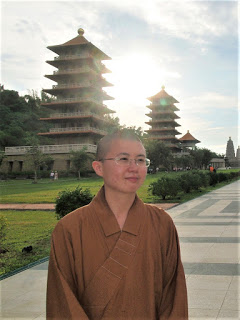
Speaker: Ven. You Lu
Fo Guang Shan Buddha Museum
I. Introduction
Hi everyone, thank you for tuning in to the English Dharma Services. This is You Lu, and today I would like to share the Mahakapi Jataka, which is the past life story of the Buddha when he was a monkey. This story is from the Pali canon, Jataka No. 516, and you can also find this jataka in the Chinese Sutra of the Collection of Six Paramitas.
III. Mahakapi Jataka
i. The Cause for Recounting the Story
This story was told by the Buddha when dwelling in the Bamboo Grove, about Devadatta hurling a stone at him. When the assembly blamed Devadatta for having hurled a stone at the Buddha, the Buddha said, “This is not the first time Devadatta has flung a stone at me,” and so saying he related a story of the past when he was a monkey.
ii. The Search for Ox
Once upon a time there was a man, who after ploughing his fields, loosened his oxen and began to work with a spade. The oxen escaped little by little into the forest. Discovering that time was late, the man laid aside his spade to look for his oxen, and was overcome with grief when he could not find them. He then wandered about the forest in search of his oxen, and he ended up in a mountainous region. Having lost his bearings, he roamed about for seven days without meals.
Then on the 8th day, seeing a fruit on a tree, he climbed up the tree and tried to rip the fruit off the branch. Unfortunately, he slipped off the tree and fell down into a gorge, where he spent another ten days.
iii. The Rescue by a Monkey
At that time a monkey, while eating wild fruits, caught sight of the man, and thought, “this poor man, if he continues to stay in the gorge, he would die for sure. Since I have made vows to save all beings, I should save him out of the gorge.”
The monkey then carried the man on his back and took him out of the gorge. When they came to a flat land, the monkey showed the man the way to leave the forest.
Having taken the man out of the gorge, the monkey became exhausted and laid down to rest. Seeing the monkey lying on the ground, the man harbored an evil intention and thought:
Monkeys and such like deer are good to eat; What if I kill him and my hunger cheat? The beast if slain would furnish savory meat. When sated, here no longer will I stay But well provisioned for full many a day Out of this forest I will find a way.
So while the monkey was asleep, the man took a stone from the ground and split the monkey’s head open. The monkey, becoming aware of his action, sprang up and hopped on to a nearby tree.
iv. The Test of Patience
Without harboring any harmful thoughts, he reflected on how the man had repaid him with such a harmful act, and pondered, “The people whom I am incapable of helping, may they constantly be in the presence of the Buddha, and may they have faith in the true teachings, so that they can practice the path, and never harbor harmful thoughts like this.”
He then cried out to the man, “I will point out to you the way to exit the forest, you will then be off, and you should never do any more harm.” The monkey set the man on the right road and then disappeared into the mountainous region. The man, because he had sinned against the monkey, became a leper, and for seven years he was overwhelmed with pain.
On one occasion, the king met the man and asked him, “Who are you, and what have you done to bring this suffering upon you?” And he told the king the whole story at length. And while the man was speaking with the king, even as he spoke, the earth opened its mouth, and at that very moment the man disappeared and was reborn in hell.
v. The Web of Connection
The Buddha here ending his lesson said, “Not only now, but formerly too, Devadatta flung a stone at me,” and he identified the Birth: “At that time the man was Devadatta, I myself was the monkey.”
VI. Mahakapi Jataka and Patience
In the Sutra of the Collection of the Six Paramitas, this jataka was classified under Patience. Why should we practice patience? In the Sutra of the Collection of the Six Paramitas it is explained in this way:
The Bodhisattva contemplates how sentient beings, due to ignorance, see themselves as more important than others, and always strive to put others down. When they see others with something better than what they have, their minds give rise to greed and jealousy, and like a drunken man, they remain for a long time in the cycle of rebirth and accumulate endless suffering. Then the Bodhisattva reflects: sentient beings suffer endlessly because of the lack of patience. Having reflected on this, the Bodhisattva then vowed never to give up on practice of patience, and he would rather be cooked alive, than to bring harm to others.
When one forbears the unbearable, he opens the door to endless merit. Having recognized the importance of patience, the Bodhisattva practices kindness in every lifetime, and every time he encounters hardship, he overcomes them through patience. Not only that, he showed kindness to his enemies, and when his enemies give up harmful acts, the Bodhisattva would rejoice for them.
So this is how a Bodhisattva practices patience, when he practices patience, he does not simply endure the situation, nor does he suppress his emotions and tries to push the hardship down his throat. He does it by constantly reflecting on the pros and cons of patience, and convinced of the benefits of patience, seeing how the lack of it will only lead us to more suffering, he is able to take on the hardship that is put on him by his enemies, and not only that, he is also willing to help his enemies with acts of kindness.
V. The Practice of Patience
So what is the practice of patience? In this jataka, when the monkey was hit on the head with a stone by the man, he did not harbor any ill intention. This is the practice of patience. For one who is not trained in patience, when he is hit on the head with a stone, he would have given rise to negative thoughts, and would have thought of hitting back.
We see such cases on news reports, of how people turn an argument into a fight when they can’t control their anger. We can experience this in our daily lives, when we are not patient enough, we give in to anger so easily, and we say words that we cannot hold back, or we do things that we come to regret some time later. As a result, relationships turn sour and we have to take even greater effort to heal the relationship. So the practice of patience helps us to remain calm and not to give rise to anger at any situation that puts us at a disadvantage, and to help us see things with a greater light that this practice is going to bring about a long-term benefit.
Apart from refraining from anger, the Bodhisattva practice of patience goes even further to act with kindness, so like what we see in this jataka, even though the monkey was hurt, he tried to help the man leave the forest. But at the same time, he did it skillfully so that he does not get hurt again. So instead of staying on the ground, luckily the monkey was strong enough to climb back up on the tree, and that keeps him safe from getting further harm from the man, but at the same time, helping the man to leave the forest.
In many jatakas, Devadatta often acted as the perpetrator, and caused a lot of trouble for the Buddha over many lifetimes. Even after the Buddha was enlightened, he continued to bring harm to the Buddha. But the relationship between the Buddha and Devadatta also tells us how the Buddha was able to perfect his practice of patience, that the Buddha cultivated a higher level of patience each time Devadatta brought harm to him. In fact, in order to cultivate patience, you need to have an enemy, because if everyone is helpful and nice to us, there is no way we can practice patience. So like what Shantideva says in the Bodhicaryavatara,
Thus since patient acceptance is produced In dependence upon (one with) a very hateful mind, That person should be worthy of veneration just like the sacred Dharma, Because he is a cause of patience.
Do you have someone like Devadatta in your life too? If you do, make full use of your relationship with this person for the cultivation of patience, like what the Buddha did. You can do that through reflection. First, recall a time when you got into an argument with this person. When you have this image in mind, think about the disadvantages of going through anger, and ask yourself: has anger helped resolve your problems in any way? Then reflect on how things might have turned out if you have exercised patience. And finally, make a mental determination to practice patience next time you encounter a similar situation.
Venerable Master Hsing Yun says, “Patience is neither passively compromising nor holding in one’s anger—it is kind and compassionate tolerance for others. Those who practice patience and compassion truly understand that all are one and equal. If achieved, everything with or without reason will become a chance for personal growth, and an increase in merit and virtue. The greatest benefit of practicing patience would be the ability to regard everything with an ordinary mind.” And as in the sutras, patience is said to bring about beauty, health, and renown. So with small steps we make in cultivating patience, we can be sure of a brighter and better future.
VI. Conclusion
That’s all I would like to share for my talk tonight. I hope you enjoyed the session. Did you have any similar experience on practicing patience? Leave us a comment and let us know. Thank you again for tuning in.
If you have not subscribed to this channel, please remember to hit the subscribe button for more Dharma wisdom, and also hit the bell button next to the subscribe button so you will not miss the latest updates.
See you next week!

